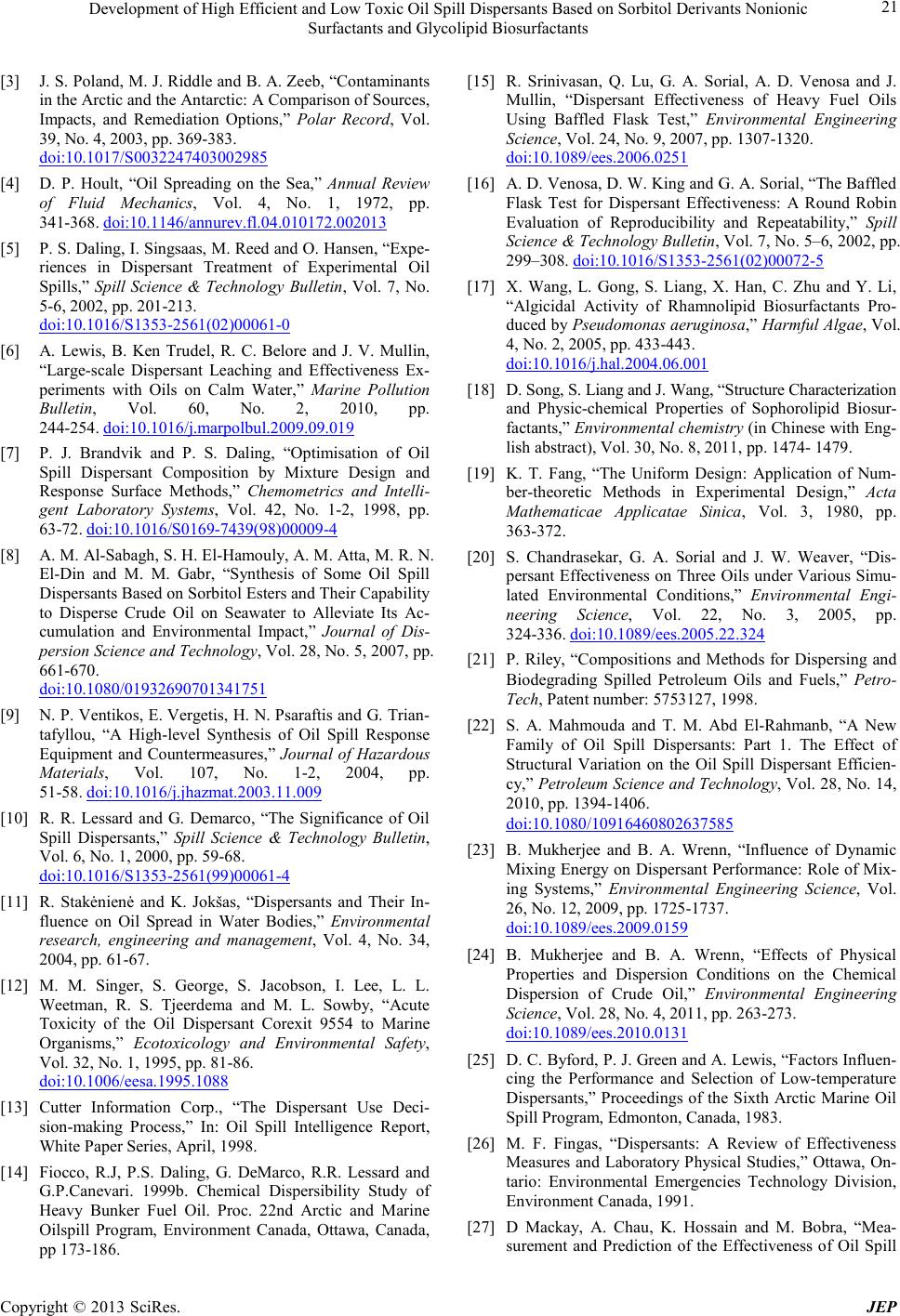
Development of High Efficient and Low Toxic Oil Spill Dispersants Based on Sorbitol Derivants Nonionic
Surfactants and Glycolipid Biosurfactants
Copyright © 2013 SciRes. JEP
[3] J. S. Poland, M. J. Riddle and B. A. Zeeb, “Contaminants
in the Arctic and the Antarctic: A Comparison of Sources,
Impacts, and Remediation Options,” Polar Record, Vol.
39, No. 4, 20 03, pp. 369-383.
doi:10.1017/S0032247403002985
[4] D. P. Hoult, “Oil Spreading on the Sea,” Annual Review
of Fluid Mechanics, Vol. 4, No. 1, 1972, pp.
341-368. doi:10.1146/annurev.fl.04.010172.002013
[5] P. S. Daling, I. Singsaas, M. Reed and O. Hansen, “ Expe-
riences in Dispersant Treatment of Experimental Oil
Spills,” Spill Science & Technology Bulletin, Vol. 7, No.
5-6, 2002, pp. 201-213.
doi:10.1016/S1353-2561(02)00061-0
[6] A. Lewis, B. Ken Trudel, R. C. Belore and J. V. Mullin,
“Large-scale Dispersant Leaching and Effectiveness Ex-
periments with Oils on Calm Water,” Marine Pollution
Bulletin, Vol. 60, No. 2, 2010, pp.
244-254. doi:10.1016/j.marpolbul.2009.09.019
[7] P. J. Brandvik and P. S. Daling, “Optimisation of Oil
Spill Dispersant Composition by Mixture Design and
Response Surface Methods,” Chemometrics and Intelli-
gent Laboratory Systems, Vol. 42, No. 1-2, 1998, pp.
63-72. doi:10.1016/S0169-7439(98)00009-4
[8] A. M . Al -Sabagh, S. H. El-Hamouly, A. M. Atta, M. R. N.
El-Din and M. M. Gabr, “Synthesis of Some Oil Spill
Dispersants Based on Sorbitol Esters and Their Capability
to Disperse Crude Oil on Seawater to Alleviate Its Ac-
cumulation and Environmental Impact,” Journal of Dis-
persion Science and Technology, Vol. 28, No. 5, 2007, pp.
661-670.
doi:10.1080/01932690701341751
[9] N. P. Ventikos, E. Vergetis, H. N. Psaraftis and G. Trian-
tafyllou, “A High-level Synthesis of Oil Spill Response
Equipment and Countermeasures,” Journal of Hazardous
Materials, Vol. 107, No. 1-2, 2004, pp.
51-58. doi:10.1016/j.jhazmat.2003.11.009
[10] R. R. Lessard and G. Demarco, “The Significance of Oil
Spill Dispersants,” Spill Science & Technology Bulletin,
Vol. 6, No. 1, 2000, p p. 59-68.
doi:10.1016/S1353-2561(99)00061-4
[11] R. Stakėnienė and K. Jokšas, “Dispersants and Their In-
fluence on Oil Spread in Water Bodies,” Environmental
research, engineering and management, Vol. 4, No. 34,
2004, pp . 61-67.
[12] M. M. Singer, S. George, S. Jacobson, I. Lee, L. L.
Weetman, R. S. Tjeerdema and M. L. Sowby, “Acute
Toxicity of the Oil Dispersant Corexit 9554 to Marine
Organisms,” Ecotoxicology and Environmental Safety,
Vol. 32, N o. 1, 19 95, pp. 81-86.
doi:10.1006/eesa.1995.1088
[13] Cutter Information Corp., “The Dispersant Use Deci-
sion-making Process,” In: Oil Spill Intelligence Report,
White Paper Seri es , April, 1998.
[14] Fiocco, R.J, P.S. Daling, G. DeMarco, R.R. Lessard and
G.P.Canevari. 1999b. Chemical Dispersibility Study of
Heavy Bunker Fuel Oil. Proc. 22nd Arctic and Marine
Oilspill Program, Environment Canada, Ottawa, Canada,
pp 173-186.
[15] R. Srinivasan, Q. Lu, G. A. Sorial, A. D. Venosa and J.
Mullin, “Dispersant Effectiveness of Heavy Fuel Oils
Using Baffled Flask Test,” Environmental Engineering
Scien ce, Vol. 24, N o. 9, 2007, pp. 1307-1320.
doi:10.1089/ees.2006.0251
[16] A. D. Venosa, D. W. King and G. A. Sorial, “The Baffled
Flask Test for Dispersant Effectiveness: A Round Robin
Evaluation of Reproducibility and Repeatability,” Spill
Science & Technology Bulletin, Vo l. 7 , No . 5–6, 2 002, p p.
299–308. doi:10.1016/S1353-2561(02)00072-5
[17] X. Wang, L. Gong, S. Liang, X. Han, C. Zhu and Y. Li,
“Algicidal Activity of Rhamnolipid Biosurfactants Pro-
duced by Pseudomonas aeruginosa,” Harmf ul Algae, Vo l.
4, N o. 2, 2005, pp. 433-443.
doi:10.1016/j.hal.2004.06.001
[18] D. Song, S . Liang and J. Wang, “St ructu r e C haracterization
and Physic-chemical Properties of Sophorolipid Biosur-
factants,” Environ mental chemistry (in Chinese with Eng-
lish abst r a c t) , V ol . 30, No. 8, 201 1, pp. 1474- 1479.
[19] K. T. Fang, “The Uniform Design: Application of Num-
ber-theoretic Methods in Experimental Design,” Acta
Mathematicae Applicatae Sinica, Vol. 3, 1980, pp.
363-372.
[20] S. Chandrasekar, G. A. Sorial and J. W. Weaver, “Dis-
persant Effectiveness on Three Oils under Various Simu-
lated Environmental Conditions,” Environmental Engi-
neering Science, Vol. 22, No. 3, 2005, pp.
324-336. doi:10.1089/ees.2005.22.324
[21] P. Riley, “Compositions and Methods for Dispersing and
Biodegrading Spilled Petroleum Oils and Fuels,” Petro-
Tech, Patent num be r : 5753127, 1998.
[22] S. A. Mahmouda and T. M. Abd El-Rahmanb, “A New
Family of Oil Spill Dispersants: Part 1. The Effect of
Structural Variation on the Oil Spill Dispersant Efficien-
cy,” Petroleum Science and Technology, Vol. 28, No. 14,
2010, pp . 1394-1406.
doi:10.1080/10916460802637585
[23] B. Mukherjee and B. A. Wrenn, “Influence of Dynamic
Mixing Energy on Dispersant Performance: Role of Mix-
ing Systems,” En vironmental Engineering Science, Vol.
26, No. 12, 2009, pp. 1725-1737.
doi:10.1089/ees.2009.0159
[24] B. Mukherjee and B. A. Wrenn, “Effects of Physical
Properties and Dispersion Conditions on the Chemical
Dispersion of Crude Oil,” Environmental Engineering
Scien ce, Vol. 28, N o. 4, 2011, pp. 263-273.
doi:10.1089/ees.2010.0131
[25] D. C. Byford, P. J. Green and A. Lewis, “Factors Influen-
cing the Performance and Selection of Low-temperature
Dispersants,” P roceedings of the Sixth Arctic Marine Oil
Spill Program, Edmonton, Canada, 1983.
[26] M. F. Fingas, “Dispersants: A Review of Effectiveness
Measures and Laboratory Physical Studies,” Ottawa, On-
tario: Environmental Emergencies Technology Division,
Envir onment Ca na da , 1991.
[27] D Mackay, A. Chau, K. Hossain and M. Bobra, “Mea-
surement and Prediction of the Effectiveness of Oil Spill